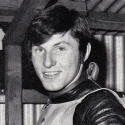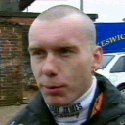
| Home | Contact Us | Articles |
| Books - DVDs | Stadia Pix | Programme Generator |
A History of Long Eaton Speedway
Speedway was first staged at Station Road in Long Eaton in 1929 and 1930, but it was a short-lived venture and only three meetings were held. This was fairly typical of those pioneer years when tracks would appear and disappear again in a matter of weeks. The sport didn't reappear in the town until 1951 when the Long Eaton Archers lined up in the third division of the National League. The team finished second bottom of the table, above a Wolverhampton side that was well adrift at the foot.
A change in the structure of the sport saw the club take its place in the 1952 Southern League. Unfortunately the crowds attracted were too low to justify the club continuing and the Archers withdrew from the league, their results being expunged from official records. Many other tracks were to close in the year or two that followed, many due to the crippling 'entertainment tax' levied by the post-war government.
The sport didn't really take an upturn until the Provincial League was formed in 1960. Long Eaton was one of many tracks to reopen and join the 'cheap and cheerful' league. The Archers returned in time for the 1963 season under the promotion of Reg Fearman. They finished second bottom in that year and again the following year, but the venue was returning a useful profit for Fearman and for the first time in its history the club was actually stable.
The all-embracing British League saw the Archers thrown into competition with the 'big boys' of the sport and glamour clubs like Belle Vue, Coventry and West Ham began to visit Station Road. Long Eaton struggled a little to attract riders and it was no real surprise when they finished bottom of the league. They managed to finish second bottom in 1966, but the year will always be remembered as the year that Ove Fundin turned out for the Archers. Fundin appeared in five meetings for the Archers and is undoubtedly the greatest rider to ever be a fully-fledged Long Eaton rider.
When Fundin wasn't around the Archers relied on Ray Wilson and Ray Cresp to bring home the bacon. They were offered some support in 1967 by the emerging talent of Anders Michanek. Both Wilson and Michanek qualified for the 1967 World Final and the team enjoyed its best season to date - by finishing third from bottom! The Archers' faithful were in for a shock during the winter when it was announced that the club would be closing down and the licence transferred to nearby Leicester. This meant that the track lay fallow for a year, the fans either following the team to Leicester or losing contact with the sport.
 |  |
Thankfully a new promotion moved in for the 1969 season and applied for membership of the British League second division. The team was rechristened 'Long Eaton Rangers' and finished in a creditable mid-table finish - thanks largely to the efforts of Tony Lomas and Geoff Penniket.
The Rangers continued in the second division until the end of 1973, without any great success, but along the way Malcolm Shakespeare developed into a quality number one rider. For the 1974 season the team reverted to the Archers nickname for what was to prove the last in a continuous run of six years speedway at Station Road.
The bikes didn't return until 1979. The new promoter was Dan McCormick, a man with interests at Cradley Heath. McCormick decided that a whole new image was required and opted to call the team the Nottingham Outlaws. Dave Perks was recruited through McCormick's links with Cradley and proved to be one of the league's top men by storming to a ten point average. Mike Sampson was an able number two and inherited the mantle of 'top man' when Perks moved on for the 1980 season. The track closed again after that 1980 season.
Another revival followed in 1982 as the team was, once again, re-branded, this time as the Long Eaton Invaders - the name picking up on the popularity of 'space invader' arcade games in that period. Ken McKinlay was appointed team manager and was able to bring his extensive experience of riding and machine maintenance to bear. Dave Perks returned to Station Road and proved just as effective as he had in 1979. The team finished seventh in 1982, however normal service was resumed the following year when the Invaders finished bottom of the National League.
Then in 1984 - something quite incredible happened. A solid, but unspectacular, side lined up for the Invaders and went out and won the whole damn National League! A remarkable achievement when fancied sides like Berwick, Hackney and Peterborough looked significantly stronger on paper. The Invaders won the title by a single point, just edging out the Mildenhall Fen Tigers.
The eight man squad that won the league consisted of: Dave Perks, Paul Stead, Graham Drury, David Tyler, Chris Pidcock, Miles Evans, Mark Stevenson and John Frankland.
1985 was always likely to be an anti-climax and the Invaders slumped to second bottom of the league, only a truly dismal Edinburgh side finishing below them. It looked like closure would follow but Mervyn Porter saved the club. Porter had been promoter at Ellesmere Port in '85 and his Gunners side had won the league. However heavy losses forced him to move the club to Station Road. The team retained the Invaders name but lost Dave Perks to Newcastle. He was replaced by Mark Fiora and Geoff Pusey on loan from Middlesbrough. The club stumbled on for the next few seasons but in the years between 1985 and 1990 they never managed to finish outwith the bottom two of the National League. During these years riders like Keith White, Richard Hellsen, Gary O'Hare, Paul Fry and Glenn Doyle gave good service. Grasstracker Gerald Short looked to be a major discovery in this period, unfortunately a series of nasty injuries drained his confidence and his speedway career was cut prematurely short.
 |  |
In 1991 businessman Tony Mole, who had held a long association with Wolverhampton, bought the Invaders and set about rebuilding the club. His first move was to appoint Eric Boocock as his general manager, a shrewd move that brought the club immediate respect and more influence within the corridors of power. Boocock and Mole were key figures in the club's revival and another important component was Jan Staechmann. The Dane dropped down from Wolverhampton and his flamboyant personality lifted the club. He was an instant success and, along with fellow new recruits Kai Niemi and Carl Blackbird, transformed the team into a competitive and attractive side. Staechmann also brought the club some tangible success by winning the Second Division Riders Championship at Coventry.
Over the next three seasons the Invaders were always nearer the top of the table than the bottom. Entertainers like Neil Collins, Martin Dixon and Steve Johnson were recruited and the side actually, incredibly, became something of a 'glamour' outfit - in division two terms at least. Staechmann even surpassed his previous achievements by qualifying for the last ever World Final.
Staechmann moved onto Hull in 1995 and the leagues amalgamated into the all-new Premier League. This meant that the World's top riders were back at Station Road for the first time since 1967. The combined league lasted for two years and during that time several big names turned out for the Invaders. Principle amongst these were Simon Wigg, Ronnie Correy and Dukie Ermolenko. There was also a change in the promotion as Eric Boocock moved on and was replaced by Graham Drury.
When the leagues split into two divisions in 1997 it was little surprise when the Invaders opted to line up in the lower tier. Carl Stonehewer was an impressive figurehead in the Invaders assault on the title, he was supported by the ever-lively Martin Dixon and the club seemed to be in good shape. The season closed on 29th October when the Invaders defeated Exeter in the first leg of the Young Shield final.
In the early months of 1998 it became clear that all was not well. A shock announcement was made that the stadium was to be sold for housing development and that the club would have to vacate immediately. Protests were immediately made but the Invaders were forced to withdraw from the league.
Over the years that followed, the plans to build houses were continually frustrated. The local council must take enormous credit for blocking all applications to change the designated use of the land, they insisted it was for leisure and recreation and refused to reclassify the land. Thanks are also owed to the fans who maintained pressure on the council to ensure that they retained that strong position.
That dedication will now pay dividends as a new track is constructed and, starting in March 2006, new chapters can be added to the rich history of Long Eaton speedway.
This article was first published on 19th February 2005

"Just a little fine tuning to the Long Eaton history.
The sport actually returned to Station Road in 1950, not 1951. The Archers raced almost
a full season of challenge matches against second and third division teams, mostly with
loaned riders. Ernest 'Pedlar' Palmer was the first captain. He later became the
Sheffield team manager, under the Frank Varey promotion at Owlerton, and is still a
regular attender at Tigers' meetings today.
There were also three meetings at Station Road at the end of the 1954 season. These
were `pirate' meetings, run without a Control Board licence by the greyhound
promoter at the Stadium, Tom Beattie, and former Norwich rider Paddy Mills, who lived
in Leicester. Some riders used their own names, others false names. Former Archers
riders Wilf Plant (father of Graham) and Johnnie Jones took part in the meetings
under their own names. Jones, who had been riding for Brafield in the Southern Area
League in 1954, had his licence withdrawn by the Control Board and missed the chance
to compete in the SAL Riders' Championship Final."
"I have just nearly screamed my head off lol and my mates I love speedway. I was 12
when I went first time and have been a long supporter of the Long Eaton Invaders -
had jumpers everything. When they closed it down it was sad and all was forgotten.
When I heard the track was being rebuilt I couldn't believe it, so had to see it for
myself
You have made a girl of 20 very happy and I will be there again to watch.
I love the noise the smell and the atmosphere it's a shame that so many tracks are
being closed down due to funding. Thanks for cheering me up."
"Well what a superb article,I have been looking for some Long Eaton speedway history and have enjoyed your article. I was fortunate to go to a few meetings there in the late 90's and enjoyed it and now hopefully will be enjoying it again soon and now I have a bit of its history. Thank you."
"It is lovely to read this article. My great uncle is Ray Cresp. As kids he would come home for the traditional Christmas reunion at his sister, Marie's house in Melbourne. We knew Uncle Ray lived in England but had no idea what he did. He wasn't a boastful man and it is amazing to see what he achieved. I for one am very proud of him. "
"Unfortunately due to the current growth in nimbys ie the residents in the area of the Long Eaton speedway circuit this great local institution remains closed as of this day. I do not know if plans are afoot to revive this once great addition to our local history and entertainment, one can only hope that someone has the money and the sense to re-open what would be a lucrative and enthralling attraction to the East Midlands."
"2011 is the year and the revival of LONG EATON has risen from the ashes in what is now known as the Midland league. Long Eaton Invaders are now racing at Beaumont leys in the new Leicester Lions camp and are facing Leicester Cubs, Exeter, Bradford and Hackney. I like many others carry LONG EATON in my heart and have many memories associated with Long Eaton from the late Archers days up to the Rangers then Nottingham Outlaws and finally the INVADERS untill the untimely death of LONG EATON SPEEDWAY and am always sad when passing Station road and Nottingham road."
"I have read your article on Long Eaton Speedway and I think it's very good. I did see the above book at Beaumont Park at the weekend but didnt have enough money on me at the time to buy it. Long Eaton is where are started watching speedway as my dad, George Wood used to work on the track staff during the Archers days. I was also a mascot at Long Eaton I used to go around the track with usually Ray Wilson. But I also had the pleasure of going around the track with the Great Ove Fundin and had my photo taken with him, which I used to have a copy of but its been misslaid somewhere."
"My dad worked on the turnstiles, I used to go with him in the early 60's. I loved the atmosphere running round the outside of the track before it opened was a thrill for a child of 8 or 9 waiting for the crowds to come in and the excitement of the crowds. We sang.... 2 4 6 8 who do we appreciate A R C H E R S Archers! "
"One of the most significant contributions of Long Eaton speedway was the winter training school that was held there over at least two winters in the late sixties. Along with Weymouth, this provided much needed practice, experience and tuition in the quiet time of year. About ten to twenty riders would attend of all levels experiences, from raw rookies to riders recovering from serious injury, under the eye of Ron Wilson and other family members. My father and I volunteered there, covering the dog track, selling fuel out of a large tank and flagging down in the event of regular falls. Don't think that would happen today! We even took the injured Pete Reading to Nottingham General with a broken collarbone. An amazing time!"